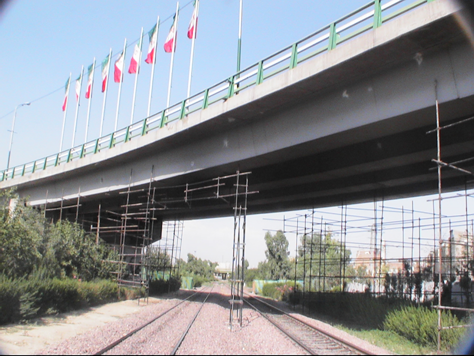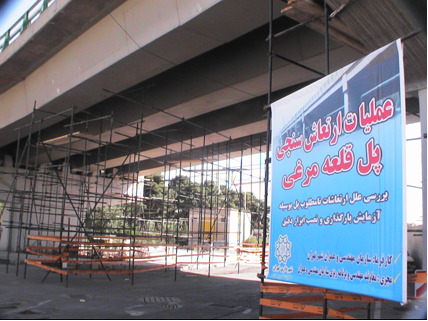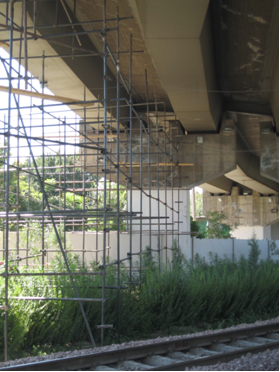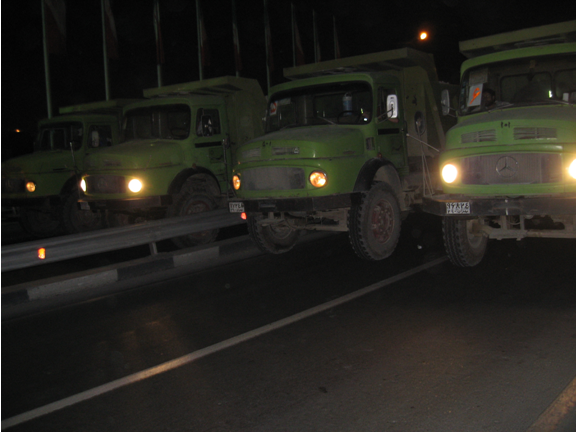Ghalemorghi Bridge Load Test Client : Tehran Municipality Consultant : Iranian Railways, Tracks and substructures division Contractor : Dr. Sharvan Ataei Contractor colleague: Dr. Davood Younesian Clip of experinent 
pic.1 
pic.2 
pic.3 
pic.4 Ghalemorghi Bridge is located at the end of Ghalemorghi Street in Tehran and creates an adequate space for 4 lines to pass over odd and even lines of South Railway tracks. The 225-meter Ghalemorghi Bridge has seven spans (30+30)+(30+45+30)+(30+30) and the deck on the third support has lateral expansion joint. The bridge is located in a horizontal curve with a radius of 140 meters. The bridge deck composed of four composite curved steel box girders with a height of 1.8 m and a distance of 4.4 m from one another. The width of this four-line railway track is 18 m (1.5+3.7+3.9+3.5+1.5). Each column in the supporter stands on a circular neoprene. In the load test and vibration monitoring of the bridge, the third and fourth spans of (30+45+30)-meter deck were instrumented. The lengths of this three-span deck in the first and fourth traffic line are 101 and 112 m., respectively. The first and second spans of the deck were instrumented and all three spans were loaded. In Ghalemorghi test, 102 sensors were utilized. In this test, acceleration in 34 points, deflections in 39 points and the strains in 29 points were recorded. The measurement instruments were attached to five sections of the deck from which three sections on the column, two sections on the center of the third (30 m.) and fourth span were selected. The load test started at 00:30 A.M., Monday 1386/6/17 through blocking the bridge. The test was terminated at 04:00 A.M. The loading program included the following tests: influence line test, harmonic test, static bending test, static tension test, dynamic bending test, and dynamic tension test. During the whole test, six 28-ton trucks were used. In addition, an articulated truck passed over the bridge and the bridge response was measured. In the influence line test, the 28.22 ton truck No. 1 passed lines 1 and 4, moving ahead and back, with the speed of 5 and 40 Km/h. In sum, 16 series of tests were conducted. The harmonic test was carried out by six trucks in a chain (No. 1-6) with a distance of 15 m. passing over four lines with a speed of 20 Km/h. In this loading, the bridge behavior in response to the harmonic load in a period of 3/8 sec. was measured. In the static bending test, the second axis of the trucks No. 3, 4, 5, 6 with the weight of 28.16, 27.9, 27.55, and 27.7, respectively were placed in lines 1, 2, 3, and 4. This test was conducted twice in the middle of the third, fourth, fifth and in ¼ of the forth span. On the whole, 10 series of tests were carried out. It should be mentioned that in this test each line and the whole bridge bear about 28 and 111.32 tons of load, respectively. In the static torsion test, trucks no. 3, 4, 5, and 6 were placed back to back and symmetrically on lines 3 and 4 in the middle of the third, forth, and fifth span of the bridge. Totally, three tests were carried out in this phase. In this test, lines three and four carried a load of about 55.6 and 111.32 tons, respectively. In the dynamic bending test, trucks no. 3, 4, 5, and 6 passed over the bridge with speed of 20 Km/h on lines 1, 2, 3, and 4 in a sequence. This test was conducted in two series and the trucks passed over the bridge and returned. In the dynamic tension test, trucks no. 3 and 4 followed by trucks 5 and 6 passed over the bridge on lines 3 and 4 with speed of 20 Km/h. clip of experinent |